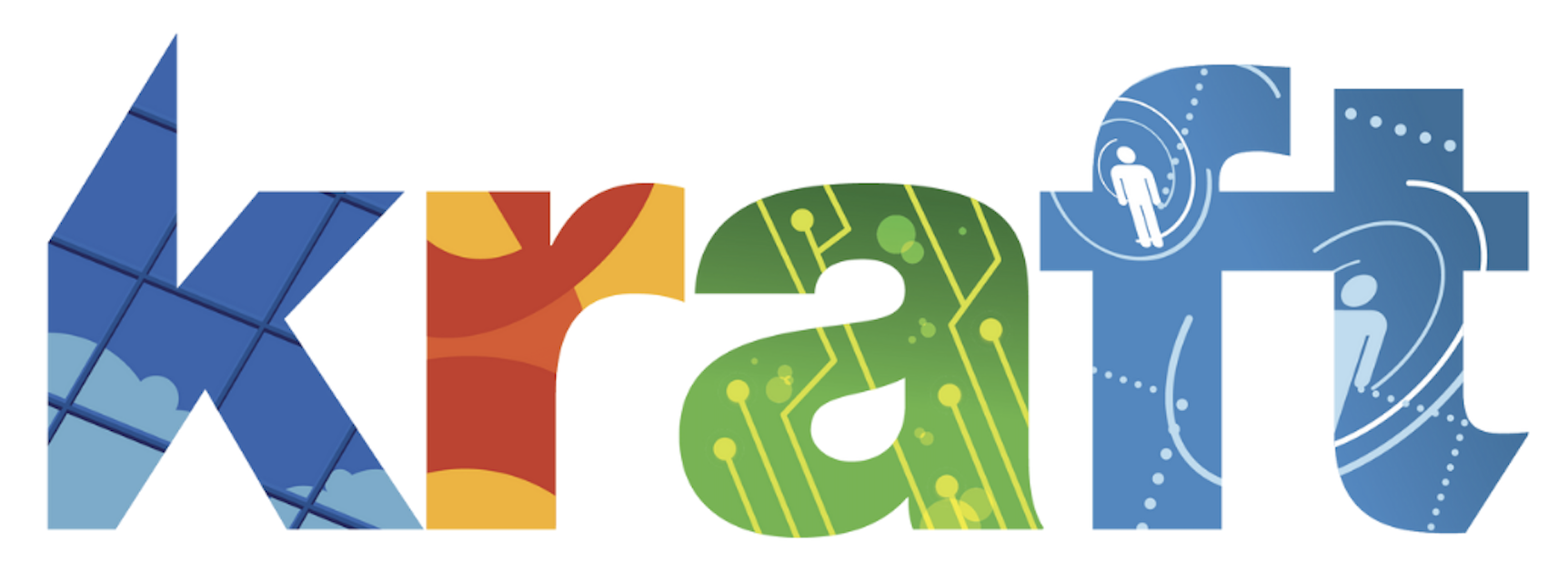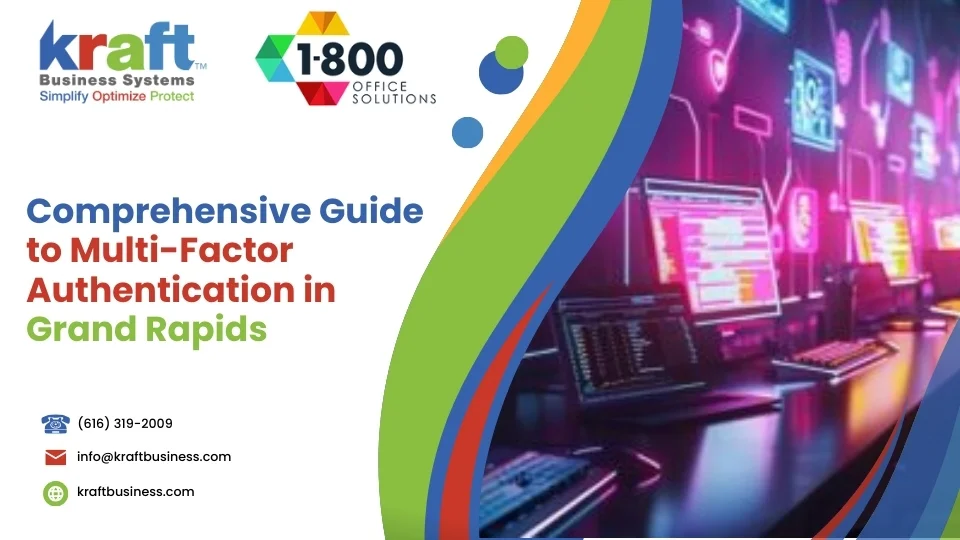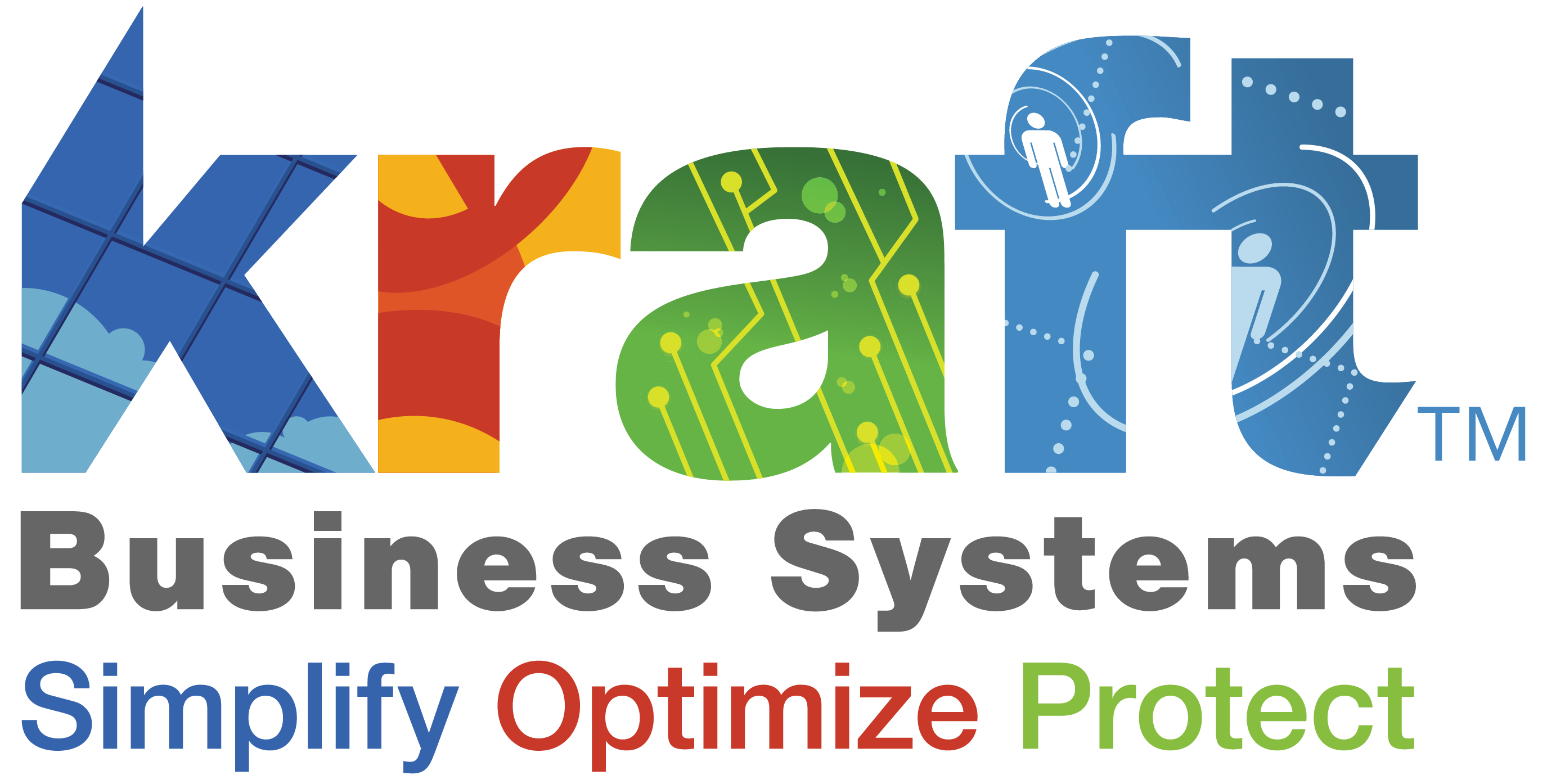Did you know that implementing multi-factor authentication can reduce the risk of unauthorized access by up to 99%? As a vital component of IT solutions and managed cybersecurity services, multi-factor authentication significantly enhances cloud security and protects your managed network security services. This article explores the role of MFA in modern security strategies, the benefits it offers to users, and the essential steps for successful implementation. By understanding MFA, business owners can effectively address security vulnerabilities and strengthen their defenses. Contact us to learn how Kraft Business Systems can safeguard your operations.
Key Takeaways
- MFA enhances security by requiring multiple verification methods
- implementing MFA reduces risks of unauthorized access and data breaches
- MFA ensures compliance with industry standards and regulatory requirements
- utilizing MFA increases user trust and confidence in security measures
- integrating MFA with existing systems is essential for robust protection
Understand the Role of Multi-Factor Authentication in Security
Multi-Factor Authentication (MFA) employs various methods to enhance security assessment and protect passwords against threats like spam email and unauthorized access. By adhering to industry standards, MFA supports encryption, mobile device security, and regulatory compliance through cloud security and managed network security services. Real-world examples illustrate how MFA effectively safeguards personal information and reinforces overall security awareness. For more information, contact us.
Recognize Various Methods Used in Multi-Factor Authentication
Multi-Factor Authentication (MFA) utilizes multiple verification methods to strengthen security protocols and protect sensitive information. By requiring more than one form of identification, MFA significantly reduces the risk of unauthorized access.
Common methods employed in MFA include:
- Something you know, such as a password or PIN.
- Something you have, like a mobile device or security token.
- Something you are, including biometric factors like fingerprints or facial recognition.
Implementing a combination of these methods ensures a robust defense against potential security breaches, enhancing the overall protection of business systems and data.
Identify Potential Threats Mitigated by Multi-Factor Systems
Multi-Factor Authentication (MFA) plays a critical role in mitigating various cybersecurity threats by requiring multiple forms of verification before granting access. This layered security approach, supported by cloud security and managed network security services, significantly reduces the likelihood of unauthorized breaches, ensuring that sensitive business data remains protected.
The potential threats mitigated by multi-factor systems include:
- Phishing attacks aimed at stealing user credentials.
- Brute force attempts to crack passwords through repeated trials.
- Unauthorized access resulting from lost or stolen devices.
Learn About Industry Standards for Multi-Factor Authentication
Multi-Factor Authentication (MFA) adheres to established industry standards to ensure robust security measures are in place. These standards, set by organizations like the National Institute of Standards and Technology (NIST) and the International Organization for Standardization (ISO), provide comprehensive guidelines for implementing effective authentication protocols. By integrating with cloud security and managed network security services, organizations can enhance their overall IT solutions:
Adhering to these industry standards enables businesses to enhance their security infrastructure through managed network security services and maintain compliance with regulatory requirements. Implementing standardized MFA solutions and cloud security ensures that sensitive data is effectively protected, fostering trust and reliability in business operations.
Assess How Multi-Factor Authentication Protects Personal Information
Multi-Factor Authentication (MFA) significantly enhances the protection of personal information by requiring multiple verification steps before granting access to sensitive data. This layered approach ensures that even if one authentication factor is compromised, unauthorized access remains unlikely.
Businesses utilizing MFA can effectively safeguard employee and customer data from potential breaches, reinforcing trust and maintaining compliance with data protection regulations. The following table outlines key aspects of how MFA secures personal information:
Examine Real-World Examples of Multi-Factor Authentication Effectiveness
In 2022, a major financial institution successfully thwarted a sophisticated cyberattack by implementing multi-factor authentication across its online banking platform. When malicious actors attempted to breach user accounts using stolen passwords, the additional verification step of a one-time code sent to customers’ mobile devices effectively blocked unauthorized access, ensuring the safety of sensitive financial data.
According to recent industry reports, businesses that have adopted multi-factor authentication experience a significant reduction in security breaches, with some organizations noting a decrease of up to 99.9% in unauthorized access incidents. This substantial improvement underscores MFA’s critical role in enhancing cybersecurity measures and protecting valuable business information from emerging digital threats.
Explore How Multi-Factor Authentication Supports Regulatory Compliance
Implementing Multi-Factor Authentication (MFA) is essential for businesses striving to meet various regulatory requirements. Through our IT solution, regulatory bodies across industries mandate stringent security measures to protect sensitive data, and managed cybersecurity services provide an effective solution by adding multiple layers of verification. Additionally, leveraging managed network security services and cloud security can further enhance data protection. This ensures that only authorized personnel can access critical information, thereby aiding organizations in maintaining compliance with standards such as GDPR, HIPAA, and PCI DSS. For more information, please contact us.
By adopting MFA, companies demonstrate their commitment to safeguarding personal and financial data, which is a key component of regulatory frameworks and cloud security. This proactive approach not only reduces the risk of data breaches but also enhances the organization’s reputation for reliability and trustworthiness through managed cybersecurity services. Additionally, MFA facilitates regular audits and compliance reporting, simplifying the process of adhering to legal obligations and industry best practices with the help of managed network security services.
Discover Benefits of Multi-Factor Authentication for Users
Multi-Factor Authentication (MFA) significantly enhances account safety by implementing various secure verification methods, such as cloud security. It offers convenience through diverse authentication options and seamlessly integrates into existing IT solutions. MFA boosts user confidence by ensuring robust protection, provides a cost-effective security solution through managed network security services, and delivers a positive user experience, making it an essential tool for safeguarding business operations. For more information, contact us.
Understand How Multi-Factor Authentication Enhances Account Safety
Multi-Factor Authentication (MFA) significantly strengthens account security by requiring users to verify their identities through multiple verification methods. This layered approach ensures that even if one credential is compromised, unauthorized access remains unlikely. Businesses implementing MFA can protect sensitive information more effectively, reducing the risk of data breaches and enhancing overall system integrity.
By integrating MFA, organizations provide an additional barrier against cyber threats, thereby increasing user trust and confidence in their security measures. This proactive strategy not only safeguards personal and financial data but also supports regulatory compliance, demonstrating a commitment to maintaining robust security standards.
Explore the Convenience of Various Authentication Methods
Multi-Factor Authentication (MFA) offers a range of authentication methods that cater to diverse user preferences, enhancing overall convenience. Whether through biometric verification, mobile app approvals, or hardware tokens, MFA seamlessly integrates into existing cloud security workflows, minimizing disruptions while maintaining robust security.
The flexibility of various authentication options allows businesses to implement solutions that best fit their operational needs and user environments. This adaptability ensures that employees can access necessary resources efficiently, fostering a secure and user-friendly experience without sacrificing productivity.
Recognize the Ease of Integrating Multi-Factor Solutions Into Systems
Implementing Multi-Factor Authentication into existing systems is a seamless process, allowing businesses to enhance their security measures without significant downtime.
The ease of integrating MFA solutions is demonstrated by:
- Broad compatibility with various software platforms
- Simple deployment procedures
- Scalable options to fit organizational growth
Identify Ways Multi-Factor Authentication Improves User Confidence
Implementing Multi-Factor Authentication (MFA) instills a higher level of trust among users by demonstrating a commitment to safeguarding their personal and professional information. Knowing that multiple layers of security, including cloud security and managed network security services, are in place reassures users that their accounts are protected against unauthorized access, which is particularly important for business owners who handle sensitive data. For more information about our IT solutions, contact us.
MFA also enhances user confidence by reducing the likelihood of security breaches, thereby minimizing disruptions to daily operations. This proactive approach allows users to focus on their tasks without constantly worrying about potential security threats, fostering a more secure and productive work environment.
Examine the Cost-Effectiveness of Implementing Multi-Factor Solutions
Implementing multi-factor authentication (MFA) is a cost-effective strategy for businesses, as it significantly reduces the likelihood of expensive security breaches and data compromises:
- Decrease in financial losses from cyber attacks
- Lowered expenses related to incident response and recovery
- Potential reductions in insurance premiums due to enhanced security measures
Furthermore, MFA streamlines security management, minimizing the need for extensive IT support and lowering overall operational costs. This efficiency allows businesses to allocate resources more effectively while maintaining robust protection against emerging threats.
Learn About the User Experience in Utilizing Multi-Factor Systems
Utilizing multi-factor authentication (MFA) enhances the user experience by providing streamlined and secure access to business systems. Users benefit from flexible authentication options, such as biometric verification and mobile app approvals, which simplify the login process while maintaining high security standards.
Additionally, MFA reduces the frustration associated with password management by minimizing the risk of account lockouts and unauthorized access. This reliable protection allows employees to focus on their tasks with confidence, knowing that their personal and professional information is well-protected.
Analyze Multi-Factor Authentication Implementation Steps
Implementing Multi-Factor Authentication involves defining setup requirements, preparing staff training, and integrating MFA into business processes. These foundational steps ensure a secure and efficient deployment.
Additionally, monitoring and managing the MFA system, along with reviewing feedback, helps refine authentication practices for ongoing security enhancement.
Define the Requirements for Setting Up Multi-Factor Authentication
Establishing Multi-Factor Authentication requires a thorough assessment of the existing IT infrastructure and IT solutions to ensure compatibility with chosen authentication methods. Businesses must determine the appropriate MFA solutions that align with their security policies and integrate seamlessly with current systems, including cloud security and managed network security services. Additionally, developing comprehensive user training programs is essential to facilitate smooth adoption and maximize the effectiveness of MFA implementation. For more information, please contact us.
Organizations also need to define clear authentication policies and protocols to govern the use of MFA across all access points. Selecting reliable MFA providers that offer scalable and customizable it solutions can enhance the security posture while accommodating future growth. By implementing cloud security and managed network security services, businesses can ensure a robust and efficient deployment of Multi-Factor Authentication, safeguarding their critical assets effectively.
Prepare for Staff Training on Using Multi-Factor Systems
Effective staff training is essential for the successful implementation of Multi-Factor Authentication (MFA) systems. By educating employees on the importance of MFA and how to use authentication tools, businesses can ensure seamless integration and minimize resistance to new security measures. Comprehensive training programs help staff understand their roles in maintaining cybersecurity, thereby enhancing the overall effectiveness of MFA solutions.
Additionally, ongoing support and resources should be provided to address any challenges employees may encounter while using MFA systems. Regular workshops, informative materials, and accessible helpdesk services can reinforce best practices and keep security protocols top of mind. This proactive approach not only improves user proficiency but also strengthens the organization’s defense against potential security threats.
Implement Multi-Factor Authentication in Business Processes
Implementing Multi-Factor Authentication (MFA) in business processes requires a structured approach to integrate security measures effectively. Kraft Business Systems outlines the following steps to ensure a successful MFA deployment:
- Evaluate existing IT infrastructure for compatibility with MFA solutions.
- Select appropriate authentication methods based on organizational needs.
- Integrate MFA with essential business applications and services.
- Provide comprehensive training to staff members on MFA usage.
By following these steps, businesses can enhance their security posture, protect sensitive data, and streamline access management, ultimately supporting a more secure and efficient operational environment.
Monitor and Manage the Multi-Factor Authentication System
Effective monitoring and management of the Multi-Factor Authentication (MFA) system are essential for maintaining a secure IT environment. Continuous monitoring ensures that authentication mechanisms operate as intended and that any irregular activities are swiftly identified and addressed. Regular system reviews and real-time tracking help in detecting potential vulnerabilities and ensuring compliance with security policies:
Managing the MFA system also involves updating authentication methods and policies to adapt to emerging security threats such as cloud security. Regular updates and managed network security services ensure that the MFA framework remains robust against new vulnerabilities. Additionally, providing ongoing training and support to employees through IT solutions helps in effectively utilizing MFA tools, thereby enhancing overall security and minimizing the risk of unauthorized access to sensitive business data.
Review Feedback and Refine Multi-Factor Authentication Practices
After deploying Multi-Factor Authentication, collecting and analyzing user feedback is essential for optimizing security measures. Kraft Business Systems regularly conducts surveys and monitors user behavior to identify any challenges or inefficiencies in the MFA process. This continuous feedback loop allows the company to make informed adjustments, ensuring that the authentication system remains both user-friendly and highly secure.
Refining Multi-Factor Authentication practices involves staying updated with the latest security trends and technological advancements, including cloud security. Kraft Business Systems leverages analytics to assess the effectiveness of current MFA methods and implements necessary improvements based on real-world performance data, utilizing managed cybersecurity services. By proactively enhancing their MFA strategies, the company ensures robust protection for business systems through managed network security services and adapts to evolving cybersecurity threats.
Compare Multi-Factor Authentication With Other Security Methods
Comparing Multi-Factor Authentication (MFA) with other security methods, such as cloud security and managed network security services, highlights its enhanced protection capabilities. This section examines the differences between single and multi-factor authentication, analyzes the strengths and weaknesses of alternative security measures, identifies scenarios where MFA is preferable, contrasts MFA with biometrics and tokens, and evaluates integration challenges with existing authentication systems.
Examine Differences Between Single and Multi-Factor Authentication
Single-factor authentication relies solely on one type of credential, typically a password or PIN, to verify a user’s identity. While this method is straightforward, it poses significant security risks, as compromised passwords can easily lead to unauthorized access.
In contrast, Multi-Factor Authentication (MFA) requires multiple forms of verification, such as something the user knows, possesses, or is. This layered approach greatly enhances security by integrating cloud security and managed network security services, making it more difficult for attackers to breach accounts:
- Combining a password with a fingerprint scan or facial recognition.
- Requiring a PIN along with a security token or mobile device confirmation.
- Implementing biometric data and a one-time code sent to a user’s device.
Analyze Strengths and Weaknesses of Alternative Security Measures
Alternative security measures, such as single-factor authentication, rely solely on one type of credential, typically a password. While simple to implement, this approach is vulnerable to various attacks, including phishing and brute force attempts, which can easily compromise user accounts and sensitive data.
Other methods like token-based authentication add an extra layer of security by requiring a physical device for access. However, these solutions can be costly and may complicate user experiences, making them less flexible compared to multi-factor authentication, which seamlessly integrates multiple verification steps to provide robust protection without significantly impacting usability.
Identify Scenarios Where Multi-Factor Authentication Is Preferable
Multi-Factor Authentication is particularly advantageous for businesses handling sensitive financial information, such as banking institutions and e-commerce platforms. By requiring additional verification steps, companies can ensure that only authorized personnel access critical financial data, thereby minimizing the risk of fraud and unauthorized transactions. This extra layer of security is essential in maintaining customer trust and safeguarding against sophisticated cyber threats.
Additionally, organizations that comply with stringent regulatory standards, such as healthcare providers and legal firms, benefit significantly from implementing Multi-Factor Authentication. Regulatory frameworks like HIPAA and GDPR mandate robust security measures to protect personal and sensitive information. MFA not only helps in meeting these compliance requirements but also enhances overall data protection, ensuring that confidential client information remains secure from potential breaches.
Understand How Multi-Factor Compares to Biometrics and Tokens
Multi-Factor Authentication (MFA) enhances security by integrating biometric verification and token-based methods, offering a comprehensive defense against unauthorized access through our managed network security services. Biometrics, such as fingerprint or facial recognition, provide unique and difficult-to-replicate identifiers, ensuring that the user is genuinely who they claim to be. Meanwhile, tokens, whether physical devices or digital keys, add an additional layer of security by requiring possession of a specific object or access to a secure application. For more information, contact us.
When comparing MFA to standalone biometric or token-based systems, MFA delivers a more robust security solution. By combining multiple authentication factors, MFA mitigates the vulnerabilities inherent in relying on a single method. For instance, even if a biometric identifier is compromised, the additional token requirement significantly reduces the risk of unauthorized access, thereby offering enhanced protection for sensitive business information.
Evaluate Integration Challenges With Existing Authentication Systems
Integrating Multi-Factor Authentication (MFA) with existing authentication systems can present significant technical challenges, particularly for organizations utilizing legacy infrastructure. Ensuring seamless compatibility often requires extensive customization and updates, which may strain IT resources and extend implementation timelines.
Furthermore, the financial investment associated with deploying MFA solutions can be a hurdle for some businesses. Beyond initial setup costs, companies must account for ongoing expenses related to system maintenance, user training, and potential upgrades to support the enhanced security measures effectively, such as cloud security and managed network security services.
Explore Future Trends in Multi-Factor Authentication
Future MFA trends include advancements in biometric authentication technologies, leveraging artificial intelligence for enhanced security through managed cybersecurity services, and using user behavior analytics to detect threats. Emerging standards and practices are setting new benchmarks, while integrating MFA with IoT devices and cloud security ensures comprehensive protection. Additionally, managed network security services are becoming integral to these developments, which are crucial for maintaining robust security frameworks.
Investigate Advancements in Biometric Authentication Technologies
Advancements in biometric authentication technologies are significantly enhancing the effectiveness of Multi-Factor Authentication (MFA) within IT solutions. Innovations such as improved fingerprint sensors, facial recognition algorithms, and iris scanning provide more accurate and reliable user verification, reducing the likelihood of false positives and unauthorized access through managed cybersecurity services. To ensure comprehensive protection, integrating cloud security and managed network security services is essential.
These biometric advancements are seamlessly integrated into MFA systems, offering a higher level of security while maintaining user convenience. By leveraging sophisticated biometric data, businesses can ensure that only authorized individuals gain access to sensitive information, thereby strengthening their overall cybersecurity posture.
Learn About the Role of Artificial Intelligence in Authentication
Artificial Intelligence (AI) enhances authentication processes by analyzing user behavior and identifying unusual patterns. This advanced capability allows Multi-Factor Authentication systems to adapt dynamically, providing a more secure and efficient method for protecting sensitive information.
AI-driven authentication methods can significantly reduce security breaches by accurately detecting and responding to potential threats. Businesses adopting AI-enhanced MFA benefit from improved threat detection and streamlined user experiences, ensuring robust security without compromising accessibility:
- Behavioral Analytics: Monitors user activities to identify deviations from normal patterns.
- Adaptive Authentication: Adjusts authentication requirements based on real-time risk assessments.
- Automated Threat Detection: Identifies and mitigates security threats without manual intervention.
- Continuous Learning Algorithms: Continuously improve authentication accuracy by learning from new data.
Explore the Impact of User Behavior Analytics on Security
User Behavior Analytics (UBA) enhances security by monitoring and analyzing user activities to identify abnormal patterns that may indicate potential threats. When integrated with Multi-Factor Authentication, UBA provides an additional layer of protection, ensuring that access requests are not only verified through multiple factors but also validated against typical user behavior.
This advanced approach allows businesses to detect and respond to suspicious activities in real-time, reducing the risk of unauthorized access and data breaches through managed network security services. By leveraging UBA, organizations can proactively strengthen their managed cybersecurity services, providing business owners with greater assurance that their sensitive information remains secure. For more information, contact us.
Term:
Identify Emerging Multi-Factor Authentication Standards and Practices
As the cybersecurity landscape continues to evolve, new standards and practices for Multi-Factor Authentication (MFA) are emerging to address sophisticated threats. These advancements focus on enhancing authentication reliability and user experience, ensuring robust protection for sensitive business data.
Emerging MFA standards prioritize seamless integration and adaptive security measures, such as cloud security and managed cybersecurity services, allowing organizations to respond dynamically to potential risks. Additionally, managed network security services provide comprehensive protection. For customized IT solutions, contact us. The following table outlines key emerging standards and their primary features:
Assess the Integration of Multi-Factor Authentication With IoT Devices
Kraft Business Systems recognizes that integrating Multi-Factor Authentication (MFA) with Internet of Things (IoT) devices significantly strengthens security measures for connected environments. This integration ensures that each IoT device requires multiple verification steps, reducing the risk of unauthorized access and enhancing the protection of sensitive business data against cyber threats.
By implementing MFA for IoT devices, businesses can effectively manage device authentication and monitor access more rigorously. This proactive approach not only safeguards critical infrastructure but also ensures that only authorized personnel can interact with essential systems, thereby maintaining the integrity and reliability of the overall security framework.
Recognize Challenges in Adopting Multi-Factor Authentication
Implementing Multi-Factor Authentication (MFA) involves overcoming common barriers such as user resistance, technical limitations, and associated costs. Additionally, businesses must address the challenge of maintaining user privacy while deploying MFA systems by utilizing cloud security and managed network security services.
Successfully navigating these challenges is essential for integrating effective MFA solutions, safeguarding sensitive data, and enhancing overall security infrastructure.
Identify Common Barriers to Multi-Factor Authentication Implementation
One significant barrier to implementing Multi-Factor Authentication is the initial cost and resource allocation required for integration. Many businesses, especially small to medium-sized enterprises, may find the financial investment and time commitment challenging when upgrading their existing security infrastructure to support MFA solutions.
Another common obstacle is the resistance to change from employees who are accustomed to traditional authentication methods. Ensuring smooth adoption of MFA requires comprehensive training and effective communication to demonstrate the benefits, thereby minimizing disruptions and fostering a culture of security awareness within the organization.
Understand User Resistance and How to Address It
Employees may resist adopting Multi-Factor Authentication (MFA) because they perceive it as an additional hassle or are unfamiliar with the new process:
- Simplify the authentication process by using intuitive technology.
- Provide thorough training and resources to educate users on MFA benefits.
- Offer prompt support to address any issues or concerns during implementation.
By addressing these concerns proactively, organizations can ease the transition to MFA and encourage greater acceptance among their workforce.
Explore Technical Limitations and Solutions for Multi-Factor Systems
One of the primary technical limitations of Multi-Factor Authentication (MFA) is its compatibility with legacy systems. Many older IT infrastructures were not designed to support advanced authentication protocols, making integration challenging. To address this, businesses can invest in middleware solutions that bridge the gap between outdated systems and modern MFA technologies, ensuring seamless implementation without the need for complete system overhauls.
Another significant technical hurdle is the potential impact on network performance and user experience. Implementing MFA can sometimes lead to slower authentication processes, which may frustrate users and reduce productivity. To mitigate this, organizations can select MFA solutions that are optimized for speed and reliability, such as cloud security and managed network security services, and conduct thorough testing to balance security enhancements with minimal disruption to daily operations.
Examine the Costs Associated With Multi-Factor Authentication
Implementing Multi-Factor Authentication (MFA) involves initial costs that businesses must carefully consider. These expenses include purchasing MFA software licenses, acquiring necessary hardware tokens or biometric devices, and integrating the system with existing IT solutions infrastructure and managed network security services. Additionally, businesses may incur costs related to customizing the MFA solution to fit their specific security requirements, including cloud security and managed cybersecurity services. While these upfront investments can be substantial, they are essential for establishing a robust security framework that protects sensitive data and mitigates the risk of costly security breaches.
Beyond the initial setup, ongoing costs associated with MFA include system maintenance, regular updates, and continuous staff training to ensure effective usage. Businesses must also account for potential scaling expenses as they grow and require additional authentication measures for more users and devices. To address these needs, many turn to managed cybersecurity services and managed network security services as part of their it solutions. Despite these recurring costs, the investment in MFA proves valuable by preventing data breaches, reducing the financial impact of cyberattacks, and ensuring compliance with regulatory standards. Ultimately, the long-term savings and enhanced security posture provided by MFA make it a cost-effective solution for safeguarding business operations, especially in environments leveraging cloud security.
Learn About Maintaining User Privacy While Using Multi-Factor Authentication
Maintaining user privacy is paramount when implementing Multi-Factor Authentication (MFA). Kraft Business Systems ensures that all personal data collected during the MFA process is securely stored and complies with relevant privacy regulations. By utilizing encrypted channels and limiting data access to authorized personnel, the company safeguards sensitive information from potential breaches.
Furthermore, Kraft Business Systems adopts a transparent approach by informing users about the data collected and how it is used in the authentication process. This clarity fosters trust and reassures users that their privacy is respected while benefiting from enhanced security measures. Continuous monitoring and regular privacy assessments help the company uphold stringent privacy standards alongside robust authentication protocols.
Frequently Asked Questions
What role does multi-factor authentication play in security?
Multi-factor authentication (MFA) strengthens security by requiring users to provide multiple verification methods. This layered approach makes unauthorized access more difficult, protecting sensitive business data from potential breaches.
For businesses utilizing managed IT services, MFA is essential in safeguarding systems and ensuring compliance. By integrating MFA, companies can enhance their cybersecurity posture and maintain trust with their clients.
How does multi-factor authentication benefit users?
Multi-factor authentication (MFA) enhances security by requiring multiple verification steps, reducing unauthorized access risks. For business owners, MFA safeguards sensitive data and systems, ensuring robust protection against cyber threats.
Implementing MFA improves user trust and compliance with industry standards. It streamlines secure access management, making it easier for organizations to maintain control over their IT infrastructure and mitigate potential breaches effectively.
What steps are needed to implement multi-factor authentication?
Implementing multi-factor authentication begins with assessing current security frameworks and identifying essential access points. Select appropriate authentication methods, such as biometric scanners or authentication apps, that align with your business requirements and enhance protection.
Next, integrate the chosen MFA solutions into all relevant systems and applications. Provide training for employees to ensure smooth adoption and establish support channels for assistance. Continuously monitor and update the authentication processes to maintain optimal security levels.
How is multi-factor authentication different from other security methods?
Multi-factor authentication (MFA) strengthens security by requiring users to provide two or more verification factors, such as a password and a mobile device code. This layered approach makes unauthorized access significantly more difficult compared to single-factor methods like traditional passwords.
In contrast to other security methods that rely solely on one form of authentication, MFA offers enhanced protection against cyber threats. By combining multiple verification steps, businesses can better safeguard sensitive information and reduce the likelihood of security breaches.
What are the future trends for multi-factor authentication?
Multi-factor authentication (MFA) is evolving with biometric advancements, such as fingerprint and facial recognition, enhancing security for businesses. These methods offer seamless user experiences while strengthening protection against unauthorized access.
Artificial intelligence is set to play a significant role in MFA by analyzing user behavior and detecting anomalies in real-time. Additionally, passwordless authentication solutions are gaining traction, simplifying access management and reducing dependency on traditional passwords.
Conclusion
Multi-Factor Authentication is essential for modern cybersecurity, providing robust protection for sensitive business data against a range of threats. By employing multiple verification methods, MFA enhances access control and ensures adherence to industry standards and regulatory requirements. Businesses that implement MFA experience increased user confidence, minimized risk of security breaches, and achieve long-term cost savings. Adopting Multi-Factor Authentication is crucial for maintaining a secure IT infrastructure and building trust in today’s digital environment.






